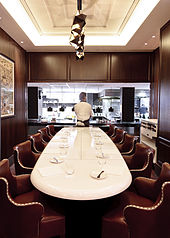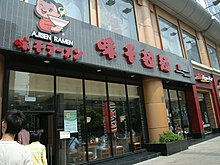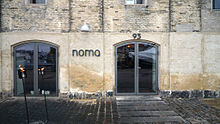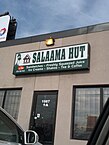Restaurant
This article has multiple issues. Please help improve it or discuss these issues on the talk page. (Learn how and when to remove these messages)
|


A restaurant (/ˈrɛstərənt/ or /ˈrɛstərɒnt/; French: [ʀɛs.to.ʁɑ̃] ), or an eatery, is a business which prepares and serves food and drinks to customers in exchange for money. Meals are generally served and eaten on the premises, but many restaurants also offer take-out and food delivery services, and some only offer take-out and delivery. Restaurants vary greatly in appearance and offerings, including a wide variety of cuisines and service models ranging from inexpensive fast food restaurants and cafeterias to mid-priced family restaurants, to high-priced luxury establishments.
In Western countries, most mid- to high-range restaurants serve alcoholic beverages such as beer, wine and light beer. Some restaurants serve all the major meals, such as breakfast, lunch, and dinner (e.g., major fast food chains, diners, hotel restaurants, and airport restaurants). Other restaurants may only serve a single meal (e.g., a pancake house may only serve breakfast) or they may serve two meals (e.g., lunch and dinner) or even a kids' meal.
Types
Restaurants may be classified or distinguished in many different ways. The primary factors are usually the food itself (e.g. vegetarian, seafood, steak); the cuisine (e.g. Italian, Chinese, Japanese, Indian, French, Mexican, Thai) and/or the style of offering (e.g. tapas bar, a sushi train, a tastet restaurant, a buffet restaurant or a yum cha restaurant). Beyond this, restaurants may differentiate themselves on factors including speed (see fast food), formality, location, cost, service, or novelty themes (such as automated restaurants).
Restaurants range from inexpensive and informal lunching or dining places catering to people working nearby, with modest food served in simple settings at low prices, to expensive establishments serving refined food and fine wines in a formal setting. In the former case, customers usually wear casual clothing. In the latter case, depending on culture and local traditions, customers might wear semi-casual, semi-formal or formal wear. Typically, at mid- to high-priced restaurants, customers sit at tables, their orders are taken by a waiter, who brings the food when it is ready. After eating, the customers then pay the bill. In some restaurants, such as workplace cafeterias, there are no waiters; the customers use trays, on which they place cold items that they select from a refrigerated container and hot items which they request from cooks, and then they pay a cashier before they sit down. Another restaurant approach which uses few waiters is the buffet restaurant. Customers serve food onto their own plates and then pay at the end of the meal. Buffet restaurants typically still have waiters to serve drinks and alcoholic beverages. Fast food restaurants are also considered a restaurant.
The travelling public has long been catered for with ship's messes and railway restaurant cars which are, in effect, travelling restaurants. Many railways, the world over, also cater for the needs of travellers by providing railway refreshment rooms, a form of restaurant, at railway stations. In the 2000s, a number of travelling restaurants, specifically designed for tourists, have been created. These can be found on trams, boats, buses, etc.
Restaurant staff
A restaurant's proprietor is called a restaurateur /ˌrɛstərəˈtɜːr/; like 'restaurant', this derives from the French verb restaurer, meaning "to restore". Professional cooks are called chefs, with there being various finer distinctions (e.g. sous-chef, chef de partie). Most restaurant (other than fast food restaurants and cafeterias) will have various waiting staff to serve food, beverages and alcoholic drinks, including busboys who remove used dishes and cutlery. In finer restaurants, this may include a host or hostess, a maître d'hôtel to welcome customers and to seat them, and a sommelier or wine waiter to help patrons select wines.
Chef's table

A chef's table is a table located in the kitchen of a restaurant,[2][3] reserved for VIPs and special guests.[4] Patrons may be served a themed[4] tasting menu prepared and served by the head chef. Restaurants can require a minimum party[5] and charge a higher flat fee.[6] Because of the demand on the kitchen's facilities, chef's tables are generally only available during off-peak times.[7]
By region
History
Greece and Rome
In Ancient Greece and Ancient Rome, thermopolia (singular thermopolium) were small restaurant-bars that offered food and drinks to customers. A typical thermopolium had little L-shaped counters in which large storage vessels were sunk, which would contain either hot or cold food. Their popularity was linked to the lack of kitchens in many dwellings and the ease with which people could purchase prepared foods. Furthermore, eating out was considered a very important aspect of socializing.
In Pompeii, 158 thermopolia with a service counter have been identified across the whole town area. They were concentrated along the main axis of the town and the public spaces where they were frequented by the locals.[8]
-
A Roman thermopolium in Pompeii
China


In China, food catering establishments which may be described as restaurants were known since the 11th century in Kaifeng, China's capital during the first half of the Song dynasty (960–1279). Probably growing out of the tea houses and taverns that catered to travellers, Kaifeng's restaurants blossomed into an industry catering to locals as well as people from other regions of China.[9] There is a direct correlation between the growth of the restaurant businesses and institutions of theatrical stage drama, gambling and prostitution which served the burgeoning merchant middle class during the Song dynasty.[10] Restaurants catered to different styles of cuisine, price brackets, and religious requirements. Even within a single restaurant much choice was available, and people ordered the entree they wanted from written menus.[9] An account from 1275 writes of Hangzhou, the capital city for the last half of the dynasty:
"The people of Hangzhou are very difficult to please. Hundreds of orders are given on all sides: this person wants something hot, another something cold, a third something tepid, a fourth something chilled; one wants cooked food, another raw, another chooses roast, another grill."[11]
The restaurants in Hangzhou also catered to many northern Chinese who had fled south from Kaifeng during the Jurchen invasion of the 1120s, while it is also known that many restaurants were run by families formerly from Kaifeng.[12]

The birth of the modern restaurant - Paris in the 18th century
The modern idea of a restaurant – as well as the term itself – appeared in Paris in the 18th century.[13] For centuries Paris had taverns which served food at large common tables, but they were notoriously crowded, noisy, not very clean, and served food of dubious quality. In about 1765 a new kind of eating establishment, called a "Bouillon", was opened on rue des Poulies, near the Louvre, by a man named Boulanger. It had separate tables, a menu, and specialized in soups made with a base of meat and eggs, which were said to be restaurants or, in English "restoratives". Other similar bouillons soon opened around Paris.[14] Thanks to Boulanger and his imitators, these soups moved from the category of remedy into the category of health food and ultimately into the category of ordinary food. Their existence was predicated on health, not gustatory, requirements.[15]
The first luxury restaurant in Paris, called the Taverne Anglaise, was opened at the beginning of 1786, shortly before the French Revolution, by Antoine Beauvilliers, the former chef of the Count of Provence, at the Palais-Royal. It had mahogany tables, linen tablecloths, chandeliers, well-dressed and trained waiters, a long wine list and an extensive menu of elaborately prepared and presented dishes. In June 1786 the Provost of Paris issued a decree giving the new kind of eating establishment official status, authorizing restaurateurs to receive clients and to offer them meals until eleven in the evening in winter and midnight in summer. A rival restaurant was started in 1791 by Méot, the former chef of the Duke of Orleans, which offered a wine list with twenty-two choices of red wine and twenty-seven of white wine. By the end of the century there were other luxury restaurants at the Grand-Palais: Huré, the Couvert espagnol; Février; the Grotte flamande; Véry, Masse and the cafe des Chartres (still open, now the Grand Vefour).[14]
United States
In the United States, it was not until the late 18th century that establishments that provided meals without also providing lodging began to appear in major metropolitan areas in the form of coffee and oyster houses. The actual term "restaurant" did not enter into the common parlance until the following century. Prior to being referred to as "restaurants" these eating establishments assumed regional names such as "eating house" in New York City, "restorator" in Boston, or "victualing house" in other areas. Restaurants were typically located in populous urban areas during the 19th century and grew both in number and sophistication in the mid-century due to a more affluent middle class and to suburbanization. The highest concentration of these restaurants were in the West, followed by industrial cities on the Eastern Seaboard, with the lowest number of restaurants per person located in the southern states.[16]
In contemporary times
South America
Brazil
In Brazil, restaurants varieties mirrors the multitude of nationalities that arrived in the country: Japanese, "Arab" (Lebanese), German, Italian, Portuguese and many more.
Colombia
In Colombia, a piqueteadero is a type of casual or rustic eatery.[17] Meals are often shared, and typical offerings include dishes such as chorizo, chicarron, fried organs, fried yuca, maduro and corn on the cob. Customers order the foods they want and the prepared foods are served together on a platter to be shared.[17] The word piquete can be used to refer to a common Colombian type of meal that includes meat, yuca and potatoes, which is a type of meal served at a piqueteaderos. The verb form of the word piquete, piquetear, means to participate in binging, liquor drinking, and leisure activities in popular areas or open spaces.[18]
North America
United States
In the 1970s, there was one restaurant for every 7,500 persons. In 2016, there were 1,000,000 restaurants; one for every 310 people. The average person eats out five to six times weekly. 10% of the nations workforce is composed of restaurant workers.[19]
Guides

Restaurant guides review restaurants, often ranking them or providing information to guide consumers (type of food, handicap accessibility, facilities, etc.). One of the most famous contemporary guides is the Michelin series of guides which accord from 1 to 3 stars to restaurants they perceive to be of high culinary merit. Restaurants with stars in the Michelin guide are formal, expensive establishments; in general the more stars awarded, the higher the prices.
The main competitor to the Michelin guide in Europe is the guidebook series published by Gault Millau. Unlike the Michelin guide which takes the restaurant décor and service into consideration with its rating, Gault Millau only judges the quality of the food. Its ratings are on a scale of 1 to 20, with 20 being the highest.

In the United States, the Forbes Travel Guide (previously the Mobil travel guides) and the AAA rate restaurants on a similar 1 to 5 star (Forbes) or diamond (AAA) scale. Three, four, and five star/diamond ratings are roughly equivalent to the Michelin one, two, and three star ratings while one and two star ratings typically indicate more casual places to eat. In 2005, Michelin released a New York City guide, its first for the United States. The popular Zagat Survey compiles individuals' comments about restaurants but does not pass an "official" critical assessment. FreshNYC recommends plausible New York City restaurants for busy New Yorkers and visitors alike.[21]
The Good Food Guide, published by the Fairfax Newspaper Group in Australia,[22] is the Australian guide listing the best places to eat. Chefs Hats are awarded for outstanding restaurants and range from one hat through three hats. The Good Food Guide also incorporates guides to bars, cafes and providers. The Good Restaurant Guide is another Australian restaurant guide that has reviews on the restaurants as experienced by the public and provides information on locations and contact details. Any member of the public can submit a review.
Nearly all major American newspapers employ food critics and publish online dining guides for the cities they serve. Some news sources provide customary reviews of restaurants, while others may provide more of a general listings service.
More recently Internet sites have started up that publish both food critic reviews and popular reviews by the general public.
Economics
Many restaurants are small businesses, and franchise restaurants are common. There is often a relatively large immigrant representation, reflecting both the relatively low start-up costs of the industry (thus making restaurant ownership an option for immigrants with relatively few resources) and the cultural importance of food.
Canada
There are 86,915 commercial foodservice units in Canada, or 26.4 units per 10,000 Canadians. By segment, there are:[23]
- 38,797 full-service restaurants
- 34,629 limited-service restaurants
- 741 contract and social caterers
- 6,749 drinking places
Fully 63% of restaurants in Canada are independent brands. Chain restaurants account for the remaining 37%, and many of these are locally owned and operated franchises.[24]
European Union

The EU-27 has an estimated 1.6m businesses involved in 'accommodation & food services', more than 75% of which are small and medium enterprises.[25]
United States

As of 2006, there are approximately 215,000 full-service restaurants in the United States, accounting for $298 billion in sales, and approximately 250,000 limited-service (fast food) restaurants, accounting for $260 billion.[26]
One study of new restaurants in Cleveland, Ohio found that 1 in 4 changed ownership or went out of business after one year, and 6 out of 10 did so after three years. (Not all changes in ownership are indicative of financial failure.)[27] The three-year failure rate for franchises was nearly the same.[28]
Restaurants employed 912,100 cooks in 2013, earning an average $9.83 per hour.[29] The waiting staff numbered 4,438,100 in 2012, earning an average $8.84 per hour.[30]
Jiaxi Lu of the Washington Post reports in 2014 that, "Americans are spending $683.4 billion a year dining out, and they are also demanding better food quality and greater variety from restaurants to make sure their money is well spent."[31]
Dining in restaurants has become increasingly popular, with the proportion of meals consumed outside the home in restaurants or institutions rising from 25% in 1950 to 46% in 1990. This is caused by factors such as the growing numbers of older people, who are often unable or unwilling to cook their meals at home and the growing number of single-parent households. It is also caused by the convenience that restaurants can afford people; the growth of restaurant popularity is also correlated with the growing length of the work day in the US, as well as the growing number of single parent households.[32] Eating in restaurants has also become more popular with the growth of higher income households. At the same time, less expensive establishments such as fast food establishments can be quite inexpensive, making restaurant eating accessible to many.
Regulations
In many counties, restaurants are subject to inspections by health inspectors to maintain standards for public health, such as maintaining proper hygiene and cleanliness. As part of these inspections, cooking and handling practices of ground beef are taken into account to protect against the spread of E coli poisoning. The most common kind of violations of inspection reports are those concerning the storage of cold food at appropriate temperatures, proper sanitation of equipment, regular hand washing and proper disposal of harmful chemicals. Simple steps can be taken to improve sanitation in restaurants. As sickness is easily spread through touch, restaurants are encouraged to regularly wipe down tables, door knobs and menus.[33]
Depending on local customs and the establishment, restaurants may or may not serve alcoholic beverages. Restaurants are often prohibited from selling alcoholic beverages without a meal by alcohol sale laws; such sale is considered to be activity for bars, which are meant to have more severe restrictions. Some restaurants are licensed to serve alcohol ("fully licensed"), and/or permit customers to "bring your own" alcohol (BYO / BYOB). In some places restaurant licenses may restrict service to beer, or wine and beer.[34]
See also
- Barbecue restaurant
- Communal dining
- Culinary art
- Food quality
- Food safety
- Food street
- Gastropub
- Health food restaurant
- List of buffet restaurants
- List of Michelin starred restaurants
- List of restaurant chains
- List of restaurant chains in Ireland
- List of restaurant chains in the United States
- List of restaurant terminology
- List of restaurants in Barcelona
- List of restaurants in Sweden
- List of seafood restaurants
- Lists of restaurants
- Menu engineering
- Pub
- Seafood restaurant
- Steakhouse
- Theme restaurants
- Types of restaurants
Notes and references
- ^ "Marcus". Marcus. Accessed May 21, 2015.
- ^ Ford, Elise Hartman (2006). Frommer's Washington, D.C. 2007, Part 3. Vol. 298. John Wiley and Sons. p. 162. ISBN 978-0-470-03849-9.
- ^ Blackwell, Elizabeth Canning (2008). Frommer's Chicago 2009. Vol. 627. Frommer's. p. 123. ISBN 978-0-470-37371-2.
- ^ a b Brown, Monique R. (January 2000). "Host your own chef's table". Black Enterprise: 122.
- ^ Ford, Elise Hartman; Clark, Colleen (2006). D.C. night + day, Part 3. ASDavis Media Group. p. 25. ISBN 978-0-9766013-4-0.
- ^ Miller, Laura Lea (2007). Walt Disney World & Orlando For Dummies 2008. For Dummies. p. 157. ISBN 978-0-470-13470-2.
- ^ Brown, Monique R. (January 2000). "New spin on dining: Hosting a chef's table can wow guests". Black Enterprise: 122.
- ^ Ellis, Steven J. R. (2004): "The Distribution of Bars at Pompeii: Archaeological, Spatial and Viewshed Analyses", Journal of Roman Archaeology, Vol. 17, pp. 371–384 (374f.)
- ^ a b Gernet (1962:133)
- ^ West (1997:69–76)
- ^ Keifer (2002:5–7)
- ^ Gernet (1962:133–134)
- ^ Rebecca L. Spang, The Invention of the Restaurant: Paris and Modern Gastronomic Culture (Harvard University Press, 2001), ISBN 978-0-674-00685-0
- ^ a b Fierro 1996, p. 1137.
- ^ Metzner, Paul. Crescendo of the Virtuoso: Spectacle, Skill, and Self-Promotion in Paris during the Age of Revolution. Berkeley: University of California Press, c1998 1998. http://ark.cdlib.org/ark:/13030/ft438nb2b6/
- ^ a b BOGOTÁ EATS & DRINKS: Piqueteadero "El Chorote"
- ^ Diccionario Comentado Del Español; Actual en Colombia. 3rd edition. by Ramiro Montoya
- ^ Leonard, Suzy Fleming (October 2, 2016). "Refining fine dining". Florida Today. Melbourne, Florida. pp. 1A, 6A, 7A. Retrieved October 12, 2016.
- ^ "Per Se American (New), French". Zagat. Retrieved April 29, 2013.
- ^ "Things to do in NYC". FreshNYC. Retrieved August 1, 2015.
- ^ "Best Modern Australian Restaurants in Melbourne". Accessed September 25, 2016.
- ^ CRFA's Provincial InfoStats and Statistics Canada
- ^ ReCount/NPD Group and CRFA's Foodservice Facts
- ^ "Business economy - size class analysis - Statistics Explained". Epp.eurostat.ec.europa.eu. Retrieved May 2, 2013.
- ^ 2006 U.S. Industry & Market Outlook by Barnes Reports.
- ^ Kerry Miller, "The Restaurant Failure Myth", Business Week, April 16, 2007. Cites an article by H.G. Parsa in Cornell Hotel & Restaurant Administration Quarterly, published August 2005.
- ^ Miller, "Failure Myth", page 2
- ^ Bureau of Labor Statistics, "Occupational Employment and Wages, May 2013 35-2014 Cooks, Restaurant" online
- ^ BLS, "Occupational Outlook Handbook: Food and Beverage Serving and Related Workers" (January 8, 2014) online
- ^ Jiaxi Lu, "Consumer Reports: McDonald's burger ranked worst in the U.S.," [1]
- ^ Nestle, Marion (1994). "Traditional Models of Healthy Eating: Alternatives to 'techno-food'". Journal of Nutrition Education. 26 (5): 241–45. doi:10.1016/s0022-3182(12)80898-3.
- ^ Sibel Roller (2012). Essential Microbiology and Hygiene for Food Professionals. CRC Press. pp. ch 10.
- ^ Danny May; Andy Sharpe (2004). The Only Wine Book You'll Ever Need. Adams Media. p. 221.
Bibliography
- Fierro, Alfred (1996). Histoire et dictionnaire de Paris. Robert Laffont. ISBN 2-221--07862-4.
- Gernet, Jacques (1962). Daily Life in China on the Eve of the Mongol Invasion, 1250–1276. Stanford: Stanford University Press. ISBN 0-8047-0720-0.
{{cite book}}: Invalid|ref=harv(help) - Spang, Rebecca L. (2000), The Invention of the Restaurant. Harvard University Press
- West, Stephen H. (1997). "Playing With Food: Performance, Food, and The Aesthetics of Artificiality in The Sung and Yuan". Harvard Journal of Asiatic Studies. 57 (1): 67–106. doi:10.2307/2719361. Retrieved July 9, 2013.
{{cite journal}}: Invalid|ref=harv(help) - "Early Restaurants in America". UNLV Libraries Digital Collections. University of Nevada Las Vegas. Retrieved April 30, 2013.
Further reading
- Appelbaum, Robert, Dishing It Out: In Search of the Restaurant Experience. (London: Reaktion, 2011).
- Fleury, Hélène (2007), "L'Inde en miniature à Paris. Le décor des restaurants", Diasporas indiennes dans la ville. Hommes et migrations (Number 1268-1269, 2007): 168–73.
- Haley, Andrew P. Turning the Tables: Restaurants and the Rise of the American Middle Class, 1880–1920. (University of North Carolina Press; 2011) 384 pp
- Kiefer, Nicholas M. (August 2002). "Economics and the Origin of the Restaurant" (PDF). Cornell Hotel and Restaurant Administration Quarterly. 43: 5–7. doi:10.1177/0010880402434006.
{{cite journal}}: Invalid|ref=harv(help) - Lundberg, Donald E., The Hotel and Restaurant Business, Boston : Cahners Books, 1974. ISBN 0-8436-2044-7
- Whitaker, Jan (2002), Tea at the Blue Lantern Inn: A Social History of the Tea Room Craze in America. St. Martin's Press.
External links
 Media related to Restaurant at Wikimedia Commons
Media related to Restaurant at Wikimedia Commons Quotations related to Restaurant at Wikiquote
Quotations related to Restaurant at Wikiquote



